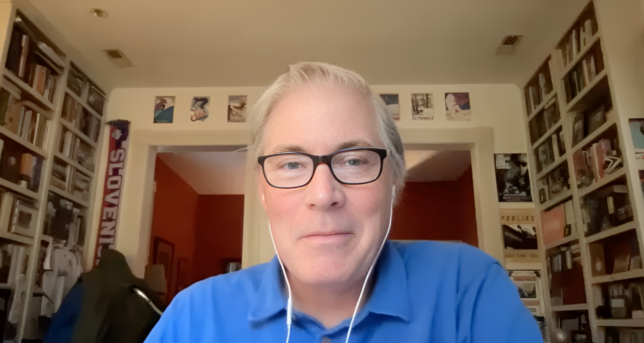Philanthropy
A Conversation with The Liberal Patriot’s John Halpin (Part 2 of 2)
The online publication’s president and executive editor talks with Michael E. Hartmann about whether partisanship in the nonprofit sector reflects philanthropic strategies, the effect of Donald Trump on the left and the right in nonprofitdom, and what could perhaps be done to change the situation for the better.
 John Halpin
John Halpin

John Halpin is president and executive editor of The Liberal Patriot, which was founded in 2021 as an online newsletter and expanded earlier this year to become a full-fledged online publication. It covers American politics, public policy, and international affairs.
Before co-founding the always-interesting TLP, Halpin was a longtime senior fellow at the Center for American Progress (CAP)—as was another co-founder, Ruy Teixeira, who’s now at the American Enterprise Institute.
Well-reflecting all of its founders’ attitudes and research interests, TLP is willing to challenge both general heterodoxy overall and specific heterodoxies. Such a challenge last month, in fact, caught our philanthro-attention. In “A Path to Institutional Pluralism,” Halpin wrote,
The networks of astroturfed “grassroots” organizations, think tanks, and other giant campaign organizations on both the left and the right today no longer function as independent bodies developing new ideas, gathering and analyzing neutral facts, brokering compromises, and supporting mutually beneficial, big-tent politics. Rather, the institutions that make up these political networks often converge on the same set of ideas and positions within a commonly accepted and enforced partisan framework that serves the interests of those currently in power—or those seeking power.
Halpin was kind enough to join me for a conversation earlier this month about these and related matters. In the first part of the discussion, which is here, he talks about liberal patriotism writ large, his expanding online publication in particular, and his background and interests.
The almost 21-and-a-half-minute video below is the second part, during which we cover whether partisanship in the nonprofit sector reflects philanthropic strategies, the effect of Donald Trump on the left and the right in nonprofitdom, and what could perhaps be done to change the situation for the better.
While “I don’t know the minds of the people who are giving the money,” Halpin tells me, “what I know is how things changed,” and how it “used to be at least, in theory and mostly in practice—a version of a kind of Madisonian pluralism.”
In the wake of the U.S. Supreme Court’s 2010 Citizens United decision, “the enforcement mechanism on the nonprofit sector” and the way it can or can’t engage “in politics went completely away,” according to Halpin. “That’s not exactly what Citizens United was about, but it happened at the same time when it basically became clear that the” Internal Revenue Service and the Federal Election Commission weren’t really going to enforce the rules anymore. “The gloves sort of came off,” and donors thought, “’All right, we’ll be more openly aligned with what we think is important from a partisan basis.’
“The second thing that happened around that time was the explosion of social media,” he notes. “So the enforcement mechanism became ‘You’re not on the team. Oh, why are they talking about this? Why is this institution doing this?’”
As time went on, “systemic racism sort of took over all of the left philanthropic world,” Halpin describes.
So then everything that the Democratic party or in any affiliated institutions did had to have some theory of systemic racism or they weren’t going to get funding. … [O]n the other side, Trump happened. He breaks the Republican party, and it probably needed to be broken in some cases, but then things became either you’re with Team Trump or you’re not.
Halpin later adds, “I think Trump drove everyone mad on the left … and I think Trump is a symptom of something that was happening. There was going to be some populist break. It already happened on the left with Occupy and [Bernie] Sanders and things like that. It was coming on the right.”
As for what could be done to improve the relationship between nonprofit charities and partisan politics, Halpin says, “You could at least enforce the rules, have enough people to enforce them, to say ‘This is not (c)(3) work anymore. You’re doing the act or work of a party or candidate.’”
Any aggressive legal or regulatory reform “would have to be uniform,” he continues.
It’s hard to imagine, given the state of politics today, you could get a neutral or perceived neutral body to do this. So I wouldn’t recommend that as a solution, because it’s not likely to work. In might enflame things.
But I think you could … if you’re the one who’s taking advantage of these through your philanthropic giving, you can just demand higher standards—like, “We’re not going to give to groups that are quasi-partisan and pretend to be something else …. We want to fund groups broadly within our ideology or across our ideology or without an ideology,” … which is, like, Madisonian pluralism.
Halpin concludes with a bit of additional, practical advice for charitable givers. “I just think it makes more sense for them to remain independent rather than to align themselves so much with any given leader or party at any time,” he says. “I don’t know why you would align your philanthropic efforts with things that have such bad images, but that’s just me.”
This article originally appeared in the Giving Review on September 20, 2023.


